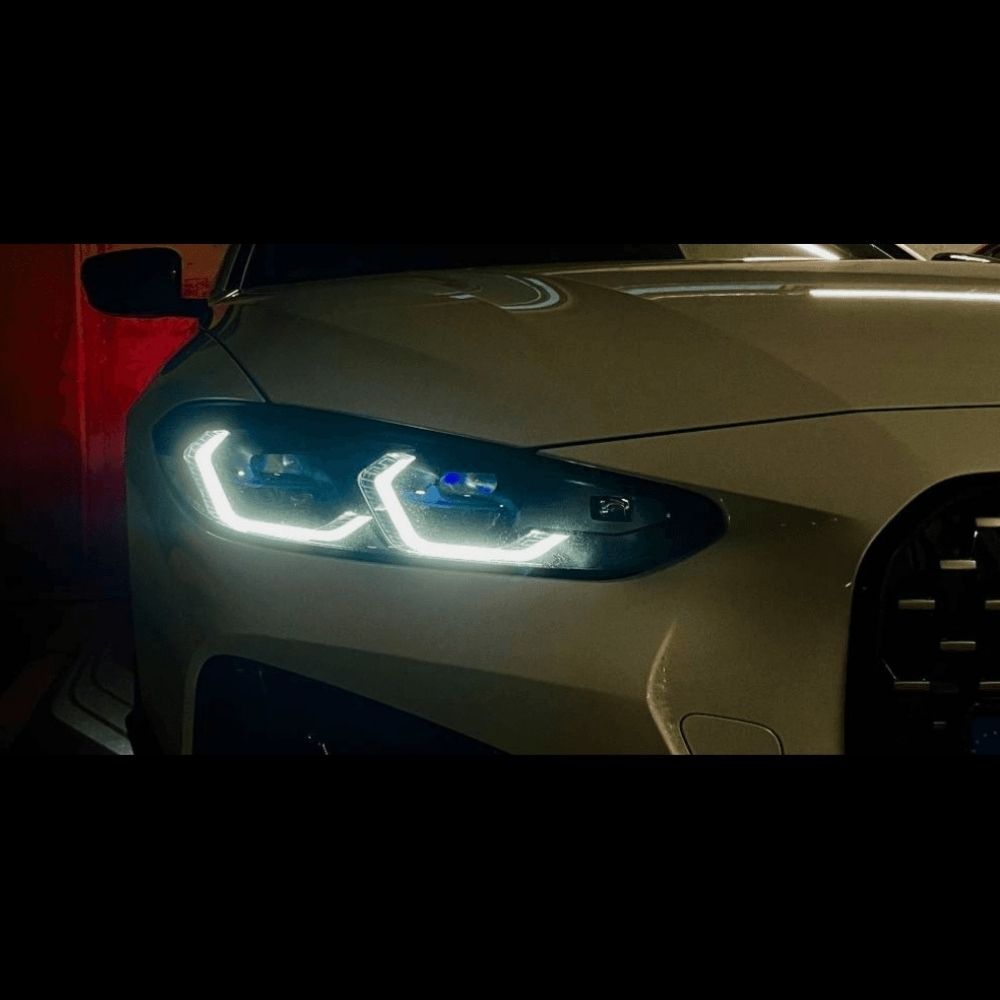
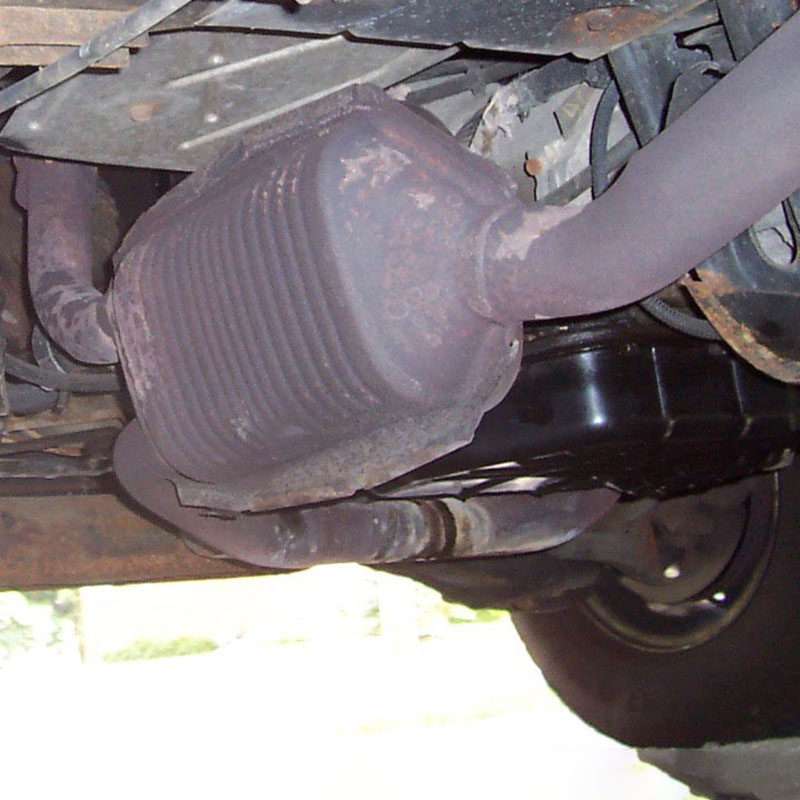
Why Catalytic Converters Matter More Than You Think
Contents
- 1. What Is a Catalytic Converter?
- 2. What Does a Catalytic Converter Do?
- 3. What Inside the Catalytic Converter
- 3.1. Stainless Steel Outer Shell
- 3.2. Heat Shielding & Insulation
- 3.3. Substrate (The Core or Monolith)
- 3.4. Washcoat Layer
- 3.5. Catalytic Material (Precious Metals)
- 3.6. Mat or Support Layer
- 3.7. Inlet and Outlet Pipes
- 3.8. Additional Internal Variants (Optional Components)
- 4. Why Catalytic Converters Are More Important Than You Think
- 4.1. They Drastically Reduce Air Pollution
- 4.2. They Help You Pass Emissions Tests (or Avoid Legal Trouble)
- 4.3. They Impact Engine Performance (and Diagnostics)
- 4.4. They’re Worth More Than You Think—Literally
- 4.5. They Keep You Legal and Compliant
- 4.6. They Help Identify Other Problems in the Vehicle
- 4.7. They Protect Public Health in a Big Way
- 5. Catalytic Converter Theft Crisis: What Every Driver Needs to Know
- 5.1. Why Are Catalytic Converters Stolen?
- 5.2. Vehicles Most at Risk
- 5.3. Signs Your Catalytic Converter Was Stolen
- 5.4. The Cost of Replacement
- 5.6. How to Protect Your Catalytic Converter from Theft
- 5.7. What to Do If Your Converter Is Stolen
- 6. Common Catalytic Converter Problems
- 6.1. Check Engine Light Comes On (Often with Codes P0420, P0430, P0171, or P0174)
- 6.2. Rattling Noise From Under the Car (Especially on Cold Start)
- 6.3. Sluggish Acceleration or Power Loss
- 6.4. Rotten Egg Smell from the Exhaust
- 6.5. Decline in Fuel Economy
- 6.6. Excessive Heat Underneath or Red-Hot Converter
- 6.7. Failed Emissions Test
- 7. How to Diagnose Catalytic Converter Issues
- 8. How to Repair a Failing Catalytic Converter: What Works and What Doesn’t
- 8.1. Catalytic Converter Cleaner (Fuel Additives)
- 8.2. High-Temperature Soak / Manual Cleaning (Off-Car)
- 8.3. Fix the Root Cause First (And See If Symptoms Improve)
- 8.4. Methods That Don’t Work (And Might Be Illegal or Dangerous)
- Technician’s Rule of Thumb:
- 9. When You Must Replace the Catalytic Converter
- 10. How to Maintain Your Catalytic Converter
- FAQ
- Conclusion
If you’ve ever asked yourself, “What is a catalytic converter?”—you’re not alone. For many car owners, the catalytic converter is just another unknown component buried under the vehicle. But this unassuming part plays a vital role not only in your car’s performance but in protecting our planet from harmful emissions. From emissions control to fuel efficiency to theft risk, the catalytic converter matters far more than you might think.
In this in-depth guide, we’ll explore what a catalytic converter does, how it works, why it’s so critical to both your engine and the environment, and what technicians and drivers need to know to maintain and protect it.
1. What Is a Catalytic Converter?
A catalytic converter is a crucial emissions control device in the catalyst system found in most modern gasoline and diesel vehicles. It reduces harmful pollutants in exhaust gases before they are released into the atmosphere. If you’ve ever wondered, “What is a catalytic converter?” — it’s essentially an emissions control device designed to transform toxic gases produced by the engine into less harmful substances before they exit the exhaust pipe.
This component is typically located between the engine and the muffler, and resembles a small metal canister with an inlet and outlet pipe. Inside, the catalytic converter houses a ceramic or metallic honeycomb structure coated with a blend of precious metals such as platinum (Pt), palladium (Pd), and rhodium (Rh) — all of which act as catalysts. These materials aren’t consumed in the process, but rather speed up chemical reactions that neutralize pollutants in the exhaust gases.
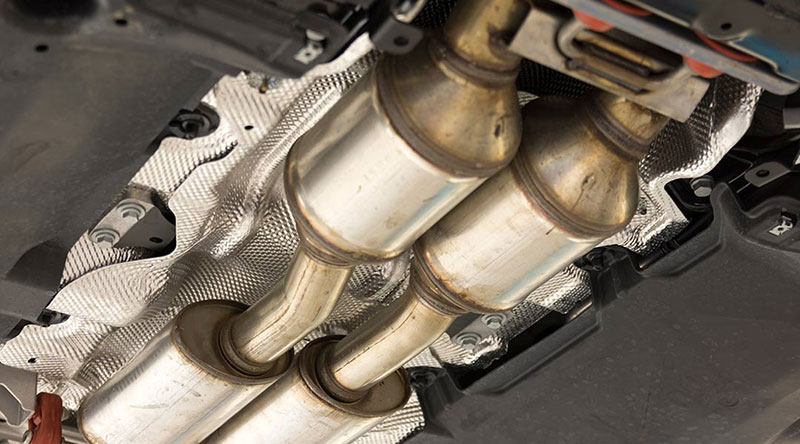
2. What Does a Catalytic Converter Do?
Modern gasoline-powered vehicles use a three-way catalytic converter, which simultaneously manages three primary chemical reactions:
-
Oxidation of Carbon Monoxide (CO → CO₂):
-
Carbon monoxide, a colorless and odorless but highly poisonous gas, is converted into carbon dioxide, which is far less harmful.
-
-
Oxidation of Hydrocarbons (HC → CO₂ + H₂O):
-
Unburned fuel in the form of hydrocarbons is oxidized into carbon dioxide and water vapor — a similar process to combustion but occurring in the exhaust stream.
-
-
Reduction of Nitrogen Oxides (NOx → N₂ + O₂):
-
Nitrogen oxides, which are major contributors to smog and acid rain, are broken down into nitrogen and oxygen gases, both naturally present in the air.
-
These reactions only occur efficiently when the converter is hot — typically reaching 400°C to 800°C (752°F to 1472°F) during normal engine operation. That’s why short trips or cold starts can reduce catalytic efficiency, as the converter doesn’t have time to reach its optimal operating temperature.
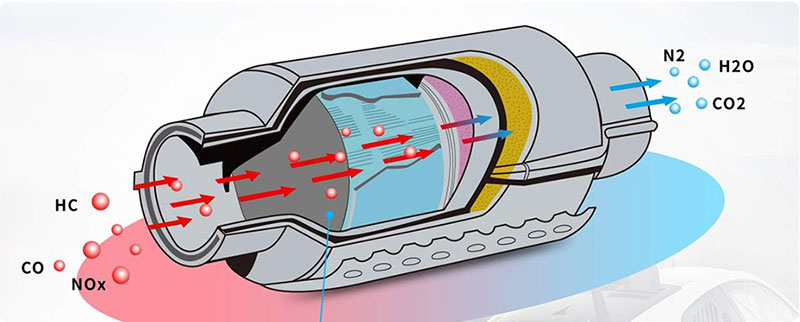
3. What Inside the Catalytic Converter
To understand how a catalytic converter works, it helps to take a closer look at what’s happening inside the metal shell. While it may seem like a simple exhaust component from the outside, the internal structure of a catalytic converter is actually a highly engineered system designed to withstand extreme temperatures, enable rapid chemical reactions, and last tens of thousands of miles.
3.1. Stainless Steel Outer Shell
The outer casing of a catalytic converter is typically made from stainless steel. This material is chosen for its ability to resist corrosion, endure intense heat, and provide physical protection to the delicate internal components.
-
Purpose: Protects the inner core and insulates heat to help maintain the converter’s optimal operating temperature.
-
Durability: Can withstand temperatures of over 900°C (1650°F).
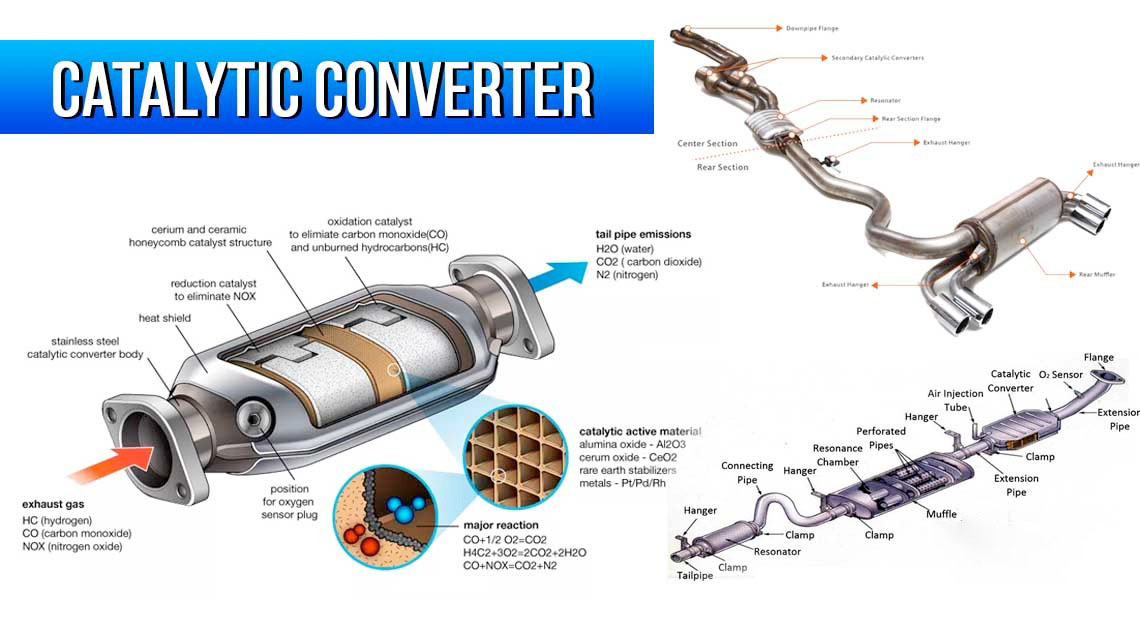
3.2. Heat Shielding & Insulation
Between the outer shell and the core lies a layer of thermal insulation. Some converters also include a heat shield as an external layer, particularly near heat-sensitive vehicle components.
-
Purpose: Maintains internal temperature for efficient catalytic reactions and protects surrounding vehicle parts from heat damage.
3.3. Substrate (The Core or Monolith)
This is the heart of the catalytic converter. The substrate is a ceramic (cordierite) or metallic honeycomb structure with thousands of tiny channels, allowing exhaust gases to pass through while maximizing contact with the catalyst.
-
Design: Honeycomb or mesh pattern to provide maximum surface area in a compact space.
-
Function: Supports the catalyst coating and allows for optimal exposure to exhaust flow.
There are two common types:
-
Ceramic Substrate: Most common; lightweight and cost-effective.
-
Metallic Substrate: Often found in performance vehicles due to better heat tolerance and strength.
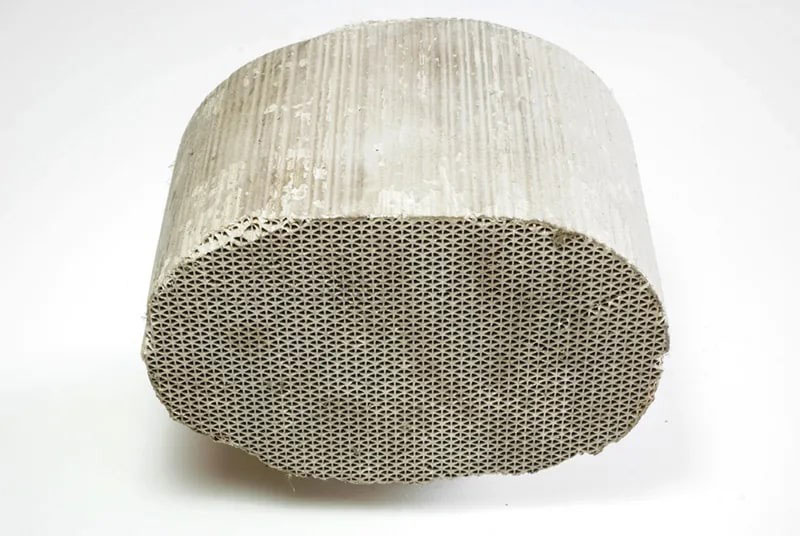
3.4. Washcoat Layer
The honeycomb substrate is coated with a “washcoat” — a rough-textured material made of aluminum oxide (alumina), cerium oxide, or other oxides. This layer dramatically increases the surface area for catalytic reactions.
-
Purpose: Increases surface area by up to 30,000 times, allowing more catalyst material to be deposited effectively.
-
Porosity: Its microscopic texture traps and holds precious metals for high reaction efficiency.
3.5. Catalytic Material (Precious Metals)
The washcoat is impregnated with precious metals that act as catalysts for the chemical reactions:
| Metal | Function |
|---|---|
| Platinum (Pt) | Oxidizes CO and hydrocarbons |
| Palladium (Pd) | Assists in oxidation of HC and CO |
| Rhodium (Rh) | Reduces NOx to nitrogen and oxygen |
These metals are extremely expensive and contribute significantly to the converter’s overall cost. Even small amounts are enough to facilitate massive chemical transformations.
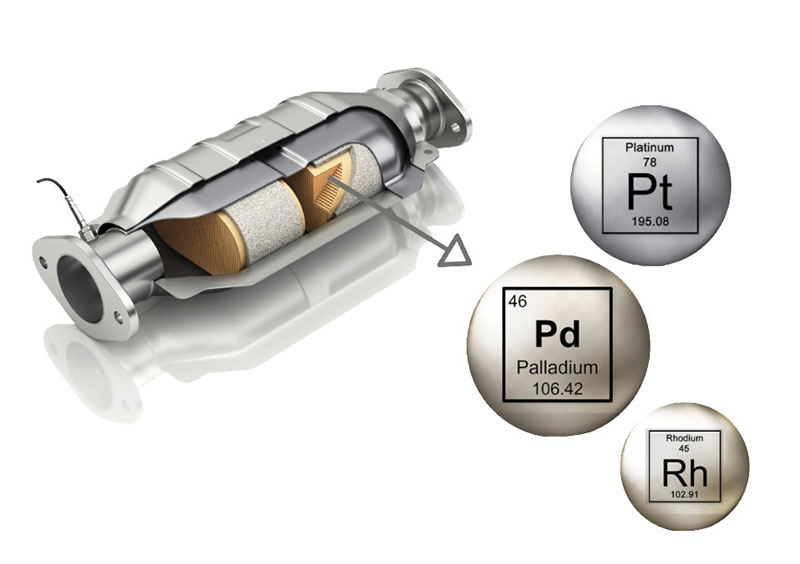
3.6. Mat or Support Layer
Surrounding the substrate is a mat or cushion layer, typically made of ceramic fiber or stainless steel mesh.
-
Purpose: Holds the substrate firmly in place and allows for expansion due to thermal cycling.
-
Shock Absorption: Protects the core from vibration, road impacts, and thermal stress.
3.7. Inlet and Outlet Pipes
The converter includes two pipes:
-
Inlet (front): Connects to the exhaust manifold; directs hot exhaust gases into the converter.
-
Outlet (rear): Connects to the muffler or rear exhaust system, allowing cleaned gases to exit the tailpipe.
Both are precisely sized to ensure correct gas flow and backpressure characteristics.
3.8. Additional Internal Variants (Optional Components)
Some advanced or high-performance catalytic converters may include:
- Oxygen Sensor Ports
Located near or inside the converter, these allow upstream and downstream O₂ sensors to monitor efficiency and fuel-air ratios in real-time.
- Dual-Stage Substrates
High-efficiency converters may have two separate substrate blocks — one optimized for reducing NOx, and one for oxidizing HC/CO.
- Integrated Catalysts
In some newer vehicles, the catalytic converter is integrated with the exhaust manifold itself for faster warm-up and better emissions control (commonly referred to as a manifold cat or close-coupled cat).
4. Why Catalytic Converters Are More Important Than You Think
A catalytic converter isn’t just a metal component in your car’s exhaust system—it’s a frontline defender against environmental pollution, engine damage, and even public health risks. Backed by real-world data, here’s why this small part carries enormous importance:
4.1. They Drastically Reduce Air Pollution
Catalytic converters play a major role in reducing vehicle emissions that contribute to smog, acid rain, and climate change. According to the U.S. Environmental Protection Agency (EPA), since catalytic converters became standard in the 1970s:
“Vehicle-related air pollutants in the United States have been reduced by more than 98% per vehicle”
— EPA, “Catalytic Converters,” 2023
These reductions apply to:
-
Carbon monoxide (CO) – ↓ ~90%
-
Hydrocarbons (HC) – ↓ ~85%
-
Nitrogen oxides (NOx) – ↓ ~90–95%

Without catalytic converters, urban centers would see significantly higher levels of smog and ground-level ozone, contributing to widespread respiratory illnesses.
4.2. They Help You Pass Emissions Tests (or Avoid Legal Trouble)
In the U.S., emissions testing is mandatory in 33 states and several Canadian provinces. According to the California Air Resources Board (CARB):
“A missing or malfunctioning catalytic converter is one of the most common causes of emissions test failure.”
— CARB Compliance Handbook, 2023
Failing an emissions test can prevent your vehicle from being legally registered, and in states like California, only CARB-certified catalytic converters are allowed for replacement—often costing $1,000 or more per unit.
4.3. They Impact Engine Performance (and Diagnostics)
While their primary job is reducing emissions, catalytic converters also impact engine efficiency and exhaust flow. A clogged converter can lead to:
-
Up to 30% reduction in engine power
-
Engine overheating
-
Drop in fuel economy by 10–15%
-
Misfire codes (P0300) and converter efficiency codes (P0420/P0430)
According to a study by the Society of Automotive Engineers (SAE):
“Exhaust backpressure from partially melted catalytic converters can raise combustion chamber temps and decrease volumetric efficiency by up to 20%.”
— SAE Technical Paper 2005-01-0635
4.4. They’re Worth More Than You Think—Literally
Catalytic converters contain precious metals like rhodium, platinum, and palladium, all of which are extremely valuable:
| Precious Metal | Average Market Price (2024) | Used For |
|---|---|---|
| Rhodium | $10,000+/oz | Reducing NOx |
| Palladium | $1,200–$1,500/oz | Oxidizing hydrocarbons and CO |
| Platinum | $900–$1,000/oz | Oxidizing hydrocarbons and CO |
This high value has fueled a massive wave of catalytic converter thefts. According to the National Insurance Crime Bureau (NICB):
“Catalytic converter thefts in the U.S. rose by over 1,215% between 2019 and 2022, with over 64,000 cases reported in 2022 alone.”
— NICB, Catalytic Converter Theft Trend Report, 2023
For many drivers, replacing a stolen converter costs anywhere from $800 to $3,000, depending on the vehicle.
4.5. They Keep You Legal and Compliant
Catalytic converters are legally required in virtually all modern vehicles sold in the U.S., Canada, Europe, and most of Asia. Removing, bypassing, or installing a non-compliant converter can lead to:
-
Fines ranging from $250 to $25,000 depending on the violation (EPA)
-
Inspection failure and inability to renew vehicle registration
-
Insurance denial in some jurisdictions after theft if not replaced with approved parts
For example, California’s CARB regulation strictly enforces aftermarket converter certification:
“Only CARB-certified converters may be installed on vehicles originally certified to California emission standards.”
— CARB, Aftermarket Catalytic Converters Regulation
4.6. They Help Identify Other Problems in the Vehicle
Catalytic converter failure often signals upstream problems such as:
-
Misfires
-
Oil burning
-
Coolant leakage
-
Incorrect fuel-air mixture
Fixing the converter without diagnosing the root cause leads to repeat failures—a common issue in budget repairs.
4.7. They Protect Public Health in a Big Way
Pollution from car exhaust is linked to asthma, cardiovascular diseases, and cancer, especially in urban populations. The World Health Organization (WHO) reports:
“Outdoor air pollution causes an estimated 4.2 million premature deaths per year globally. Traffic-related emissions are a significant contributor.”
— WHO, Ambient Air Pollution Report, 2023
Catalytic converters reduce many of the pollutants that make city air toxic—especially nitrogen oxides (NOx) and volatile organic compounds (VOCs), which contribute to ground-level ozone and smog.
5. Catalytic Converter Theft Crisis: What Every Driver Needs to Know
Catalytic converter theft is one of the fastest-growing automotive crimes in the world today — and for good reason. Thieves can remove this valuable component in under two minutes using basic tools, leaving behind thousands of dollars in damage and rendering the vehicle inoperable and illegal to drive.
So why are catalytic converters such a hot target? What vehicles are most at risk? And how can you protect yours?
5.1. Why Are Catalytic Converters Stolen?
The answer is simple: precious metals. Catalytic converters contain small amounts of highly valuable materials that act as catalysts:
| Metal | Purpose | Average Price (2024) |
|---|---|---|
| Rhodium | Reduces nitrogen oxides (NOx) | $10,000–$13,000 per ounce |
| Palladium | Oxidizes hydrocarbons and CO | $1,200–$1,500 per ounce |
| Platinum | Assists in oxidation reactions | $900–$1,000 per ounce |
Even in trace amounts, these metals can be worth hundreds of dollars when extracted and resold — especially to black-market scrap dealers who don’t ask questions.
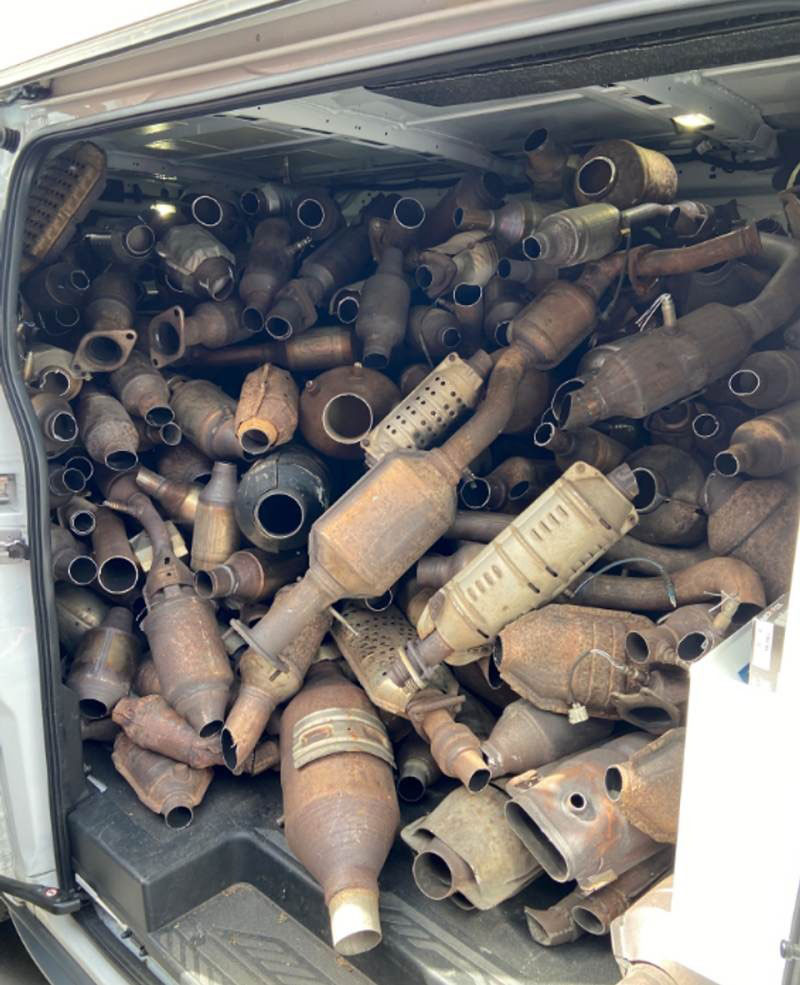
A thief can earn:
-
$50 to $300 for an average converter
-
$500 to $1,500+ for converters from hybrid, luxury, or SUV vehicles
Catalytic converter thefts have increased dramatically in recent years:
-
In the United States, the National Insurance Crime Bureau (NICB) reported:
“Over 64,000 catalytic converter thefts were reported in 2022, up from just 3,389 in 2019 — an increase of more than 1,800%.”
— NICB Catalytic Converter Theft Analysis (2023) -
In the United Kingdom, thefts rose by 104% between 2019 and 2022, according to AA Insurance.
-
Canada, Australia, and Germany have reported similar spikes due to metal price increases and organized crime involvement.
5.2. Vehicles Most at Risk
While any vehicle with a catalytic converter can be a target, thieves often go for specific makes and models that are easier to access or yield higher metal content:
Common Targets:
-
Toyota Prius (all years) – hybrid converters contain more precious metals
-
Honda Element and Accord
-
Toyota Tacoma & Tundra
-
Ford F-Series trucks
-
Lexus RX and GX models
-
SUVs and trucks – higher ground clearance makes it easier to crawl underneath
Why Hybrids Are Popular Targets:
Because hybrid engines run cooler and less frequently, the catalytic converters degrade slower — meaning they contain more intact precious metal than a gasoline-only vehicle.
5.3. Signs Your Catalytic Converter Was Stolen
If your converter has been stolen, you’ll likely notice the following immediately when starting the vehicle:
-
Extremely loud, roaring engine noise (like a racecar without a muffler)
-
Dashboard warning lights (e.g., Check Engine Light or Exhaust Malfunction)
-
Poor acceleration or rough engine idle
-
Strong smell of unfiltered exhaust fumes
-
Visible cut marks or missing exhaust components under the vehicle
5.4. The Cost of Replacement
Replacing a stolen catalytic converter can be very expensive, depending on your vehicle:
-
Standard gasoline car: $800 – $2,000
-
Hybrid vehicles (e.g., Prius): $2,000 – $4,000+
-
Luxury vehicles (e.g., Mercedes-Benz, BMW): Can exceed $5,000, especially if OEM parts are required
Additional costs may include:
-
Oxygen sensor replacement
-
Exhaust pipe repair
-
Tow truck service if the car is undriveable
5.6. How to Protect Your Catalytic Converter from Theft
The good news is: there are several effective ways to reduce your risk.
5.6.1. Install a Catalytic Converter Shield or Cage
-
Products like Cat Shield™, CatClamp™, or MillerCAT install around your converter to make removal much more difficult.
-
Cost: $100–$400, often much cheaper than replacement.
5.6.2. Etch or Engrave Your VIN
-
Marking your converter with your Vehicle Identification Number (VIN) or license plate number deters resale.
-
Many law enforcement agencies offer free etching programs.
5.6.3. Park Smart
-
Park in well-lit, high-traffic areas.
-
Avoid isolated side streets or long-term parking lots.
-
Park close to walls or fences to block access to the underside of your vehicle.
5.6.4. Install a Vibration-Sensitive Alarm
-
Some aftermarket alarms detect motion or cutting vibrations and will sound if someone tries to saw off your converter.
5.6.5. Weld the Converter to the Frame
-
Not always recommended for warranty reasons, but welding the converter can make theft more time-consuming and risky.
5.7. What to Do If Your Converter Is Stolen
-
Call the police and file a report
-
Contact your insurance company
-
If you have comprehensive coverage, they may pay for replacement.
-
-
Don’t drive the vehicle, especially if pipes are hanging or wires are exposed
-
Get a quote for a replacement converter
-
Ask if OEM or aftermarket parts are available and compliant with local laws (e.g., CARB or EPA)
-
Pro Tip: Use Anti-Theft Labels with QR Code Registration
Some anti-theft programs now offer tamper-proof labels with QR codes that link to your VIN in a law enforcement database. If the converter is stolen and resold, it can be traced back to your vehicle, aiding in theft investigations.
6. Common Catalytic Converter Problems
After learning how thieves are targeting catalytic converters, there’s another silent threat drivers often overlook: a failing catalytic converter. It doesn’t always start with a bang — sometimes, it’s a strange smell, a soft rattle, or an odd drop in power. But if you know what to look (and listen) for, you can catch it early—before it takes a toll on your engine or your wallet.
Here are the most common—and most telling—signs your catalytic converter might be in trouble, based on real-world experiences from the garage floor.
6.1. Check Engine Light Comes On (Often with Codes P0420, P0430, P0171, or P0174)
Let’s start with the most obvious signal: the Check Engine Light (CEL). Many catalytic converter problems trigger common fault codes like:
-
P0420 – Catalyst System Efficiency Below Threshold (Bank 1)
-
P0430 – Catalyst System Efficiency Below Threshold (Bank 2)
-
P0171 – System Too Lean (Bank 1)
-
P0174 – System Too Lean (Bank 2)
-
P2096 / P2098 – Post Catalyst Fuel Trim System Too Lean
Real Case:
A customer brought in a 2015 Nissan Altima with the CEL lit up and a noticeable drop in fuel efficiency. They said the car ran “fine,” but they were filling up more often. A scan revealed P0420. We checked the oxygen sensors—they were functioning—but the downstream O2 sensor was reading values nearly identical to the upstream one, meaning the converter wasn’t doing its job. Upon removal, we found the honeycomb inside was darkened and partially melted.
The customer had no idea the converter was failing—it wasn’t until the light came on and fuel economy dropped that they noticed anything.
=> You may need these post:
- P0420 Audi Fault Code: Causes and How to Fix It
- How to Fix DTC P0430 Audi: Catalyst System Efficiency Below Threshold
- What Does BMW Code P0430 Mean and How to Fix It?
- How to Fix P0430 Code Mercedes
- How to Fix Audi P0171 Error Code
6.2. Rattling Noise From Under the Car (Especially on Cold Start)
One morning, you start your car and hear what sounds like metal marbles shaking under the floor. That rattle usually means the ceramic honeycomb inside the catalytic converter has cracked or broken apart, often due to overheating or age.
Real Case:
We had a 2008 Toyota Highlander come in with a complaint of a weird rattling noise during idle and startup. The owner thought maybe a heat shield had come loose. When we lifted the vehicle, the rattle was clearly coming from inside the converter. After removing it, we shook it gently and it sounded like a spray can—the internal structure was completely shattered.
This happens when the converter is subjected to unburnt fuel (from misfires or a rich mixture), which overheats and damages the ceramic core.
6.3. Sluggish Acceleration or Power Loss
If you press the gas pedal and your car hesitates, struggles to climb hills, or just feels like it’s dragging—especially at highway speeds—it could be a partially clogged catalytic converter.
A restricted exhaust flow means the engine can’t “breathe” properly, robbing it of power.
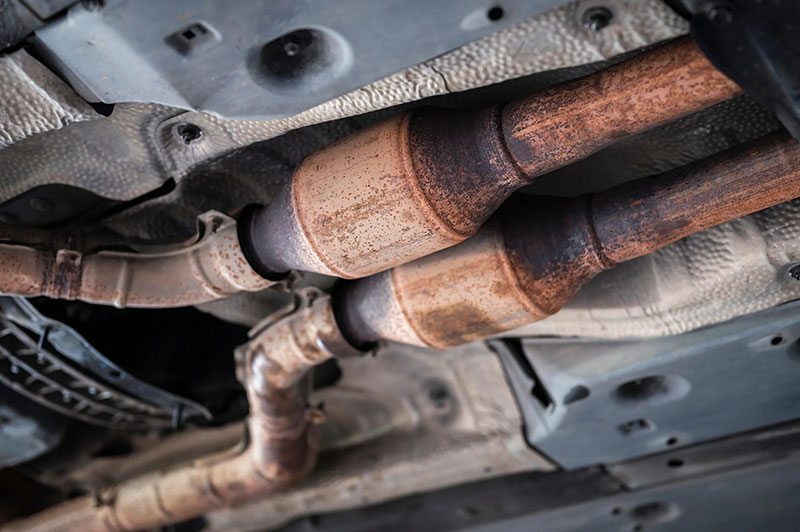
Real Case:
A customer with a 2012 Honda CR-V came in complaining that the car “just doesn’t go like it used to.” They noticed it most when trying to merge onto the freeway. No CEL was present. On test drive, we could feel the hesitation. After performing a backpressure test, we found excessive pressure upstream of the cat, confirming it was clogged by carbon buildup. We replaced it, and the engine ran like new again.
6.4. Rotten Egg Smell from the Exhaust
That awful rotten egg or sulfur smell is usually a giveaway that your converter is overheating or breaking down. It happens when the catalytic converter fails to properly process hydrogen sulfide in the exhaust gas.
Real Case:
A woman brought in her 2016 BMW X3 because her garage “smelled like sewer gas every time she parked.” The smell was strongest after longer drives. There was no CEL, but on inspection, the converter had signs of discoloration from heat and the O2 readings were erratic. The culprit? A slow oil leak into the combustion chamber was contaminating the converter, slowly killing it—and creating that awful smell.
6.5. Decline in Fuel Economy
A failing or clogged catalytic converter can cause the engine to run rich or struggle harder, leading to noticeable drops in fuel economy. If you’re making the same commute but noticing your gas tank is draining faster, your converter might be to blame.
Real Case:
A rideshare driver came in with a 2017 Chevrolet Malibu and said, “I used to get 30 mpg—now I’m down to 21.” No warning lights. We hooked up a scan tool and noticed long-term fuel trim was off, and the downstream O2 sensor had a flat reading. The converter was not functioning efficiently. After replacement, the fuel economy shot back up to 29 mpg on average.
6.6. Excessive Heat Underneath or Red-Hot Converter
When a catalytic converter becomes completely clogged, gases can’t escape quickly enough. This builds up extreme heat—sometimes enough to make the converter glow red.
Real Case:
A 2009 Ford Escape came in with a burning smell and mild smoke from under the floorboard after a road trip. The driver assumed it was a fluid leak. On inspection, the converter was glowing and the temperature downstream was over 700°C (1300°F). The internal structure had collapsed. Left unattended, this could’ve caused a vehicle fire.
6.7. Failed Emissions Test
Even if your car runs “fine,” a failing catalytic converter can result in a failed tailpipe emissions test. This is usually due to:
-
High levels of CO (carbon monoxide)
-
Excess HC (hydrocarbons)
-
High NOx (nitrogen oxides)
Real Case:
A client brought in a 2011 Mazda3 that just failed its emissions test, despite no warning lights. Emissions printout showed HC and NOx levels well above the limit. We tested the cat with a temperature gun and found almost no temperature difference between inlet and outlet—proof that no catalytic reaction was occurring.
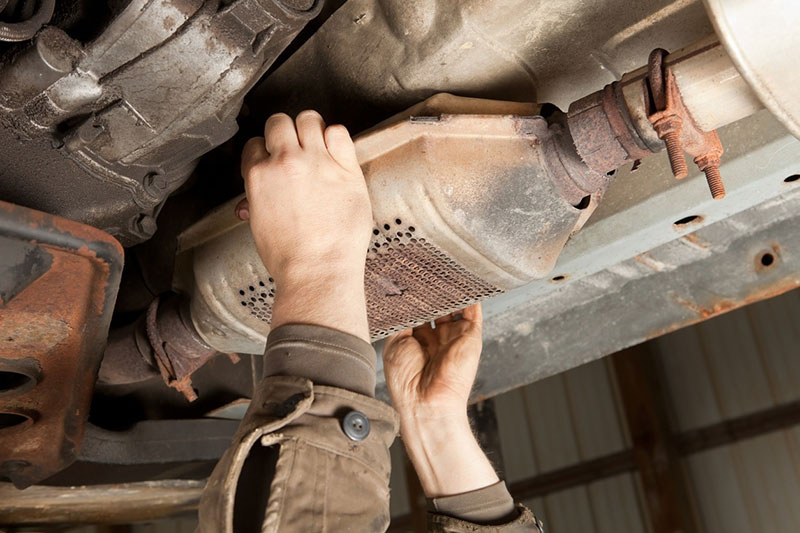
7. How to Diagnose Catalytic Converter Issues
When your car feels sluggish, smells like rotten eggs, or throws a P0420 code, your first suspect might be the catalytic converter—but how do you know for sure?
Diagnosing a catalytic converter isn’t just about reading trouble codes. A proper diagnosis involves symptom analysis, data reading, mechanical inspection, and sometimes even physical testing. Here’s how professional technicians (and DIYers with the right tools) do it step by step.
Step 1: Scan for Diagnostic Trouble Codes (DTCs)
Use an OBD2 scanner to check for codes related to catalytic converter efficiency or fuel trim. Pay special attention to:
| Common DTCs | Meaning |
|---|---|
| P0420 | Catalyst Efficiency Below Threshold (Bank 1) |
| P0430 | Catalyst Efficiency Below Threshold (Bank 2) |
| P0171 / P0174 | System Too Lean (could lead to converter overheating) |
| P0172 / P0175 | System Too Rich (causes raw fuel to overheat the cat) |
| P0300–P0306 | Misfire codes (unburnt fuel can melt the converter) |
| P2096 / P2098 | Post-catalyst fuel trim too lean |
⚠️ Tip: Don’t just clear codes and move on. Look at freeze frame data to understand the engine conditions when the fault occurred (RPM, load, temperature, etc.).
=> Related content:
- How to Use Xentry to Diagnose Mercedes Error
- How to Use ODIS Service to Diagnose VAG Vehicles’ Error
Step 2: Check Live O2 Sensor Readings
Your car uses oxygen sensors to monitor the catalytic converter’s performance. By analyzing their readings, you can determine if the converter is working properly.
What to Look For:
-
Upstream O2 sensor (pre-cat): Should show rapid fluctuations between rich and lean (0.1–0.9V on narrowband sensors).
-
Downstream O2 sensor (post-cat): Should show stable, low-activity signals if the cat is working.
Quick Test:
-
If both upstream and downstream O2 sensors show similar waveforms → the converter is not storing oxygen → likely failing.
Example: On a 2014 Audi A4, we saw matching sensor graphs on live data. The cat looked “invisible” to the downstream O2 sensor. The scan showed P0420, and the converter had physically deteriorated.
Step 3: Perform a Temperature Test
A functioning catalytic converter should get hotter at the outlet than the inlet, because the chemical reactions generate heat.
How to Do It:
-
Let the engine idle for 10–15 minutes.
-
Use an infrared thermometer or thermocouple probe to compare:
-
Inlet temperature (before the cat)
-
Outlet temperature (after the cat)
-
| Diagnosis | Temperature Result |
|---|---|
| Healthy Converter | Outlet is 100–150°F (50–85°C) hotter than inlet |
| Clogged Converter | Inlet is much hotter (heat can’t escape) |
| Failed Converter | No temperature difference at all |
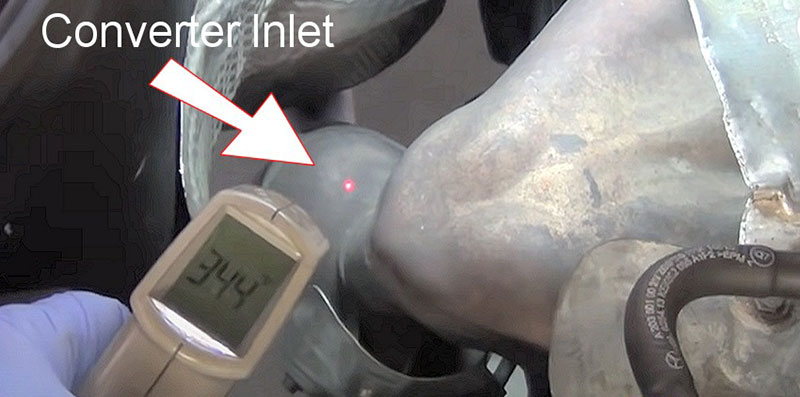
Real Case: A Ford Focus showed only a 5°F difference between inlet and outlet. The cat was not performing any reactions. Removed the cat—found it was hollow inside from internal failure.
Step 4: Test Exhaust Backpressure
When the converter is clogged, it restricts exhaust flow, creating backpressure and hurting performance.
Tools Needed:
-
Backpressure gauge OR
-
Remove upstream O2 sensor and connect a low-pressure gauge at that port.
Normal Results:
-
At idle: 0–1 psi
-
At 2,500 rpm: Less than 3 psi
If you see readings above 3–5 psi, the converter is likely clogged.
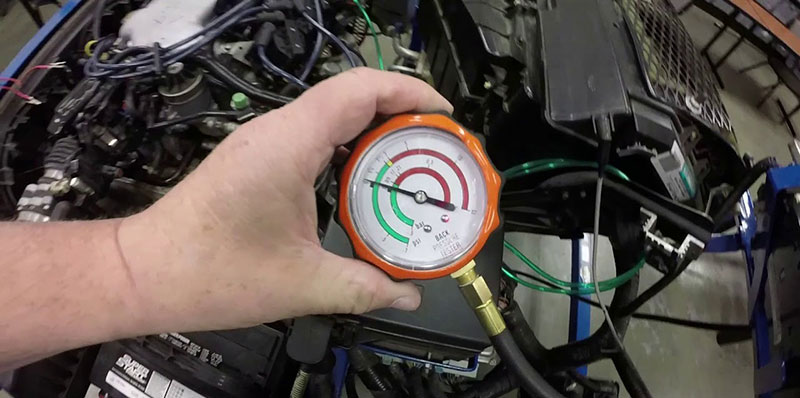
Step 5: Physical Inspection
If diagnostic methods aren’t conclusive, visual inspection can help.
What to Look For:
-
Exterior discoloration or bluing = overheating
-
Dents or impact damage = crushed core
-
Unusual rattling sounds = broken honeycomb structure
-
Melted or collapsed substrate when viewed inside
Tip: Use a borescope camera through the O2 sensor port or inlet flange to inspect the converter core.
Step 6: Eliminate Related Root Causes
Before condemning the converter, check these common upstream problems that may damage it or cause false positives:
-
Misfiring cylinders (P030x codes)
-
Rich fuel mixture (MAF sensor faults, stuck injectors)
-
Vacuum leaks
-
Faulty O2 sensors
-
Oil or coolant consumption
Many converters “fail” due to a problem up the chain. Replacing the converter without fixing the real cause = it’ll fail again soon.
8. How to Repair a Failing Catalytic Converter: What Works and What Doesn’t
8.1. Catalytic Converter Cleaner (Fuel Additives)
Best for: Minor clogging, carbon buildup, early efficiency drop (P0420/P0430)
How it works:
These are poured into your fuel tank and designed to:
-
Clean carbon and sulfur deposits from the converter
-
Improve combustion efficiency
-
Help restore flow and function
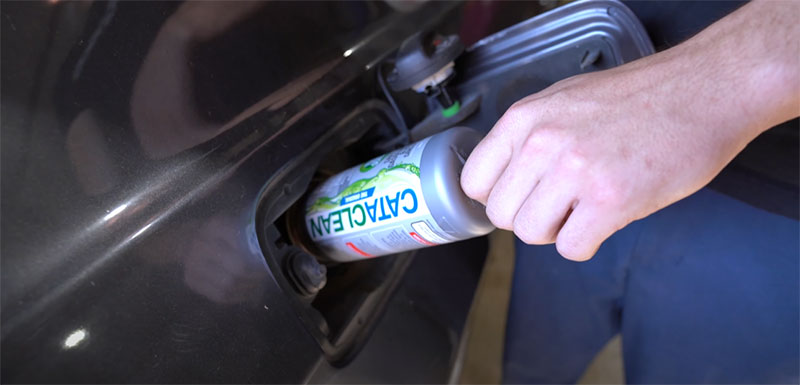
Popular brands:
-
Cataclean
-
Liqui Moly Catalytic System Cleaner
-
Chevron Techron High Mileage
Real-world note:
“We’ve seen Cataclean help in about 20–30% of early-stage converter complaints, especially when combined with fixing upstream issues like rich fuel trim or dirty injectors.”
⚠️ When it doesn’t work:
-
If the honeycomb inside is melted, broken, or physically clogged
-
If the converter is contaminated with oil or coolant (due to other engine issues)
8.2. High-Temperature Soak / Manual Cleaning (Off-Car)
Best for: Moderately clogged catalytic converters (not melted)
How it works:
-
Remove the converter from the exhaust system
-
Soak it overnight in a solution (e.g., hot water + degreaser or soap)
-
Rinse and dry thoroughly
-
Reinstall
Pro tip:
-
Use a mixture of water + degreaser (like Simple Green or Purple Power)
-
Some technicians also use citric acid or oxalic acid to break down mineral buildup
-
Rinse from both ends with pressure (but not pressure washer, which can damage the ceramic)
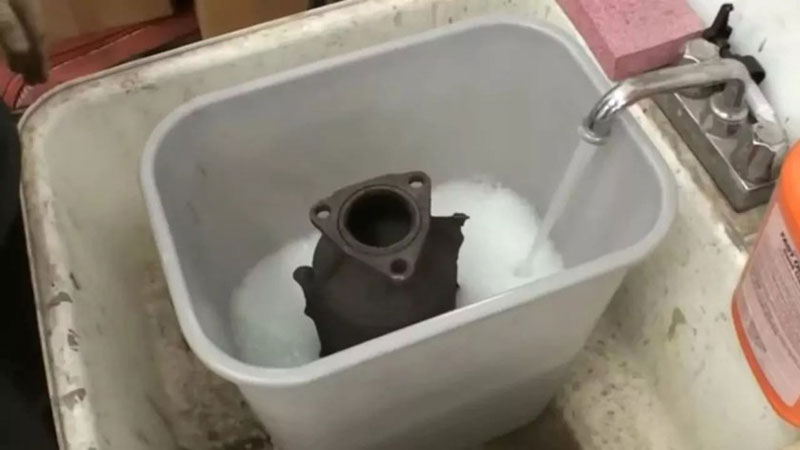
Real-world tip:
“I once revived a Civic converter by soaking it overnight and flushing it backward with warm water. Saved the customer $700.”
⚠️ Limitations:
-
Won’t restore melted or broken honeycomb
-
Labor-intensive (you must remove the cat)
-
Not legal in all regions if tampered with
8.3. Fix the Root Cause First (And See If Symptoms Improve)
Best for: Situations where cat efficiency is borderline (e.g. random P0420), but no drivability issues yet.
Sometimes, the catalytic converter is not the actual problem — it’s a victim of another issue. Common upstream causes:
-
Engine misfire
-
Rich air-fuel mixture
-
Oil burning (bad valve seals, piston rings)
-
Coolant leak (blown head gasket)
-
Faulty O2 sensors
-
Dirty or failing MAF sensor
Strategy:
-
Fix the root cause (e.g., replace O2 sensors, repair vacuum leaks)
-
Reset the ECM
-
Drive ~100–200 km to allow the ECM to relearn catalyst efficiency
-
Then recheck for codes
My Experience:
“I fixed a lean condition and replaced a bad upstream O2 sensor. Three weeks later, the customer came back — no P0420 anymore. The converter had recovered on its own.”
You may also like:
8.4. Methods That Don’t Work (And Might Be Illegal or Dangerous)
❌ “Punching Out” or Gutting the Cat
-
Removes the internal core to reduce backpressure
-
Illegal in most countries (violates emissions laws)
-
Will trigger CEL and may cause damage downstream
-
Fails inspection
❌ Using Test Pipes or Straight Pipes
-
Popular in performance tuning (but again, not road legal)
-
Eliminates the catalytic converter entirely
-
Harms air quality and exhaust sensors
-
Your vehicle will smell terrible and fail emissions testing
Technician’s Rule of Thumb:
| Condition | Recommended Action |
|---|---|
| Early-stage clog, no physical damage | Try cleaners, fix upstream problems |
| Moderate clog, no melting | Remove and soak clean manually |
| Overheating, melted, or broken core | Replace the catalytic converter |
| Converter failure + upstream issue | Fix root cause first, then reassess |
9. When You Must Replace the Catalytic Converter
If:
-
The converter is rattling internally
-
The honeycomb is melted, collapsed, or missing
-
You have high exhaust backpressure
-
You’ve failed emissions even after cleaning/fixing other systems

👉 Then it’s time to replace the converter—either with:
-
OEM (Original Equipment) for best fit and emissions compliance
-
Aftermarket / EPA-compliant converters (cheaper, but varies by quality)
-
CARB-certified converters (required in California and some U.S. states)
10. How to Maintain Your Catalytic Converter
Proper maintenance can extend the life of your catalytic converter:
- Regular Engine Maintenance: Ensure your engine is running smoothly and efficiently.
- Address Engine Misfires Promptly: Misfires can send unburned fuel to the converter, causing damage.
- Use Quality Fuel: Low-quality fuel can contaminate the catalyst.

FAQ
1. What is the lifespan of a catalytic converter?
Typically, a catalytic converter should last around 100,000 miles. However, this can vary depending on driving conditions and vehicle maintenance.
2. What happens if a catalytic converter fails?
If a catalytic converter fails, your vehicle’s emissions will increase, potentially failing emissions tests. Performance issues can also arise.
Conclusion
The catalytic converter is a vital component for reducing harmful vehicle emissions. Understanding its function and how to maintain it can contribute to both a healthier environment and a better-performing vehicle. Remember to address any warning signs promptly to avoid costly repairs and contribute to a cleaner environment.
Contact AutoExplain today for expert assistance:
WhatsApp: +1(936)2896695
Email: [email protected]
Website: AutoExplain
Office: 1500 N Grant ST Sten Denver, CO 80203


How to turn on BMW Cornering Lights?

BMW angel eyes brightness coding: How to Adjust

How to Activate BMW Speed Limit Information (SLI) on the F-Series





